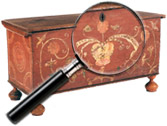|
|
Canadian or American Gameboard?
Count the squares across to determine if the board is Canadian or American. American checkers or English draughts or “straight checkers” is played on an 8 by 8 board with 12 pieces on each side. Canadian checkers is played on a 12 by 12 board with 30 pieces on each side. It is mainly played in Canada.
Information courtesy of the freedictionary.com/wikipedia November 2006
Chief Spotted Tail (1823-1881)
Spotted Tail, whose Lakota name was Sinte Gleska, served his people as a statesman and went to Washington to lobby for the rights of his people.
Information courtesy of Cowan’s Auctions Inc.
Carl Kauba (Austrian 1865-1922)
Carl Kauba was an Austrian who specialized in sculpture of Western American subjects. Kauba was a pupil of Carl Waschmann and Stefan Schwartz in Austria. He traveled widely in the American West around the mid 1890′s. After his return to Vienna his Western bronzes were cast for the American market between 1895 and 1912. Small and medium bronzes were sometimes cold painted.
Information courtesy of Cowan’s Auctions Inc., March 2007
The LaTourette Family of Weavers
Sarah LaTourette (1822-1914) was born in Germantown, Ohio, the daughter of weaver John LaTourette (1793-1849). The family moved to Fountain County, Indiana, in 1828. Sarah assisted her father, and then wove with her brother, Henry, after John died in 1849. The 1850 census lists her as a weaver, and the 1850 census of manufacturers lists her as the owner of a coverlet business. Annually, the LaTourettes wove two-hundred coverlets.
[...] Click here to continue reading.
Conestoga Wagons
The workhorse of the American road for over one hundred years beginning in the mid-18th century, the Conestoga Wagon was created by the Dutch settlers of the Conestoga Valley in Lancaster County, Pennsylvania.
Used to haul freight between towns and from farms to cities and back again, these stout wagons came in various sizes ranging from 15 to more than 26 feet overall. They could weigh up to 3,000 pounds and carry [...] Click here to continue reading.
Steinway Pianos
Steinway & Sons was founded on March 5, 1853, by the German immigrant Henry Engelhard Steinway and his sons in New York City, the center of the piano-making industry.
Henry, a master cabinetmaker, built his first piano in the kitchen of his Seesen, Germany, home. Known as the “kitchen” piano, this instrument was exhibited for many years at the Metropolitan Museum of Art and can now be seen at the factory’s gallery [...] Click here to continue reading.
Lyons Co-operative Pottery Limited
The Lyons, New York pottery began early in the 19th century and, circa 1850, was under the ownership of Nathan Clark, Jr., who was succeeded in 1867 by Thompson Harrington. In 1872 Jacob Fisher took over the pottery and operated it until 1902, the last individual proprietorship at the pottery.
From 1902 to 1904 the pottery was operated as the Lyons Co-operative Pottery Company.
From the 1850′s a variety of [...] Click here to continue reading.
The Bottle Cap Outsider Art of Grace & Clarence Woolsey
A remarkable level of obsession can be found in the bottle-cap world created by Clarence and Grace Woolsey. The many objects they made — one using at least 30,000 caps — became, after their deaths, among the most significant folk/outsider art discoveries of the 1990′s.
Their legacy includes a full-size bicycle made of caps, bottle-cap-encrusted figures several feet high that resemble aliens, bunnies [...] Click here to continue reading.
Steiff Cloth Dolls
Although best known for their mohair Teddy Bears and other stuffed animals, the Steiff toy organization traces its founding to the 1870′s when Margarete Steiff hand-made dolls for neighbor youngsters. The popularity of these led to other stuffed animals made from discarded factory scraps, which proved so well received the enterprise incorporated itself under the names of Margarete and her brother Fritz Steiff. By 1903, the company had a booming European [...] Click here to continue reading.
The Russian Imperial Porcelain Factory
Founded at St. Petersburg in 1744 by the Empress Elizabeth (daughter of Peter the Great), who entrusted a German, Chistoph Konrad Hunger, then employed in Stockholm, with a written contract to ‘found in St. Petersburg a factory for making Dutch plates and pure porcelain, as it is made in Saxony’. His first firing in the kiln was a total failure, but he always found plausible excuses. Eventually he exhausted [...] Click here to continue reading.
|
Recent Articles
- Charles Alfred Meurer – American Artist & Tromp L’Oeil Artist
- Sendak, Maurice – American Artist & Writer
- Godie, Lee – American Artist
- Davis, Vestie – American Artist
- Bartlett, Morton – American Artist
- Mackintosh, Dwight – American Artist
- Evans, Minnie Jones – African-American Artist
- Mumma, Ed (Mr. Eddy) – American Artist
- Nice, Don – American Artist
- Savitsky, John (Jack) – American Artist
- Gordon, Harold Theodore (Ted) – American Artist
- Dial, Thornton – African-American Artist
- Doyle Sam – American Artist
- Johnson, Lester Frederick – American Artist
- Finster, Howard – American Artist
|
|
